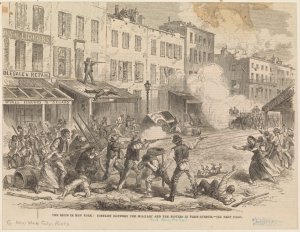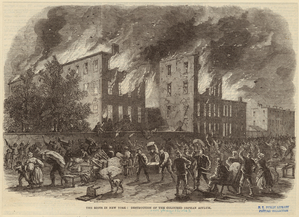Riots, Strikes, and Mobs in New York City history

Early on in the city’s history, from colonial times up until the first decade of the 19th century, rioting in New York was generally an accepted part of the city’s political culture, a legacy of English tradition. Many scholars who have written on the history of public protest in early America note that prior to the 1830s, most of the protests and more violent riots were of two kinds; either they were of a distinctly political nature, such as the post-revolutionary Anti-Federalist riots, or they were aimed at enforcing community standards and widely held moral values, such as the Doctors’ Riots in 1788 or the bawdy house raids of 1793 and 1799.
As the 19th century progressed the increased immigration and the resultant diversification of a relatively homogenous citizenry along with the onset of the industrialization of the region gave rise to novel reasons to take to the street in anger. Ethnic riots were not uncommon during the early decades of the 1800s, especially clashes between the burgeoning Irish Catholic population and the nativist Protestants, and clashes between these two groups continued for decades. The 1820s saw a large number of strikes and riots involving journeymen like weavers, stonecutters and other craftsmen whose traditional relationship with their masters were being transformed by new technologies and methods of conducting business.
From the 1830s onward, riots and demonstrations became increasingly violent in New York City, as tensions between ethnic and religious groups intensified and economic depressions caused high levels of unemployment. By the time of the Astor Place riots in 1849, New Yorkers had lost the earlier idealistic notion of having a population united by common interests and values. From the late 18th century up to the Civil War, New York went from being a city where people took to the streets to promote a common political interest or to uphold community standards to being a city where mobs instigated riots in the interest of promoting the power of particular nationalities, ethnicities, races and classes. All of the tensions between these groups came to a head in the infamous draft riots of July 1863, a nearly week long holocaust of bodies and buildings.
And the list goes on. Through the second half of the 19th century and into the 20th century there were more evolutions in the reasons and manners in which mobs formed and rioted and how the general public and authorities reacted to these manifestations. Researchers, writers and students often approach the reference desk here in the Milstein Division with questions about specific riots or about the culture of collective violence in the United States. Regardless of the needs of the researcher, whether he or she is looking for primary sources, articles, or monographs, there is a vast collection here at the library that we can tap into. For brevity’s sake I’ve included a short list of some of the sources I’ve consulted recently when helping our library users. The majority of these books are great reads in their own right, while others serve as important reference tools that lead to primary sources such as manuscript collections, newspaper articles, NGO publications, and government documents.
Great Riots of New York: 1712-1873 - by Joel Headley (1873) As with many books out of copyright, this title is available through Google Books. A few years later Headly followed up with Pen and Pencil Sketches of the Great Riots.
The Volcano Under the City - by William Stoddard (1887) This day by day recounting of the 1863 Draft riots is also available on Google Books
The Iconography of Manhattan Island: 1498-1909 - by I.N. Phelps Stokes. This 6 volume reference work is an invaluable resource for New York (county) history for events and facts, both great and small.
New York: An American City - by Sidney Pomerantz (1938)
The Road to Mobocracy: Popular Disorder in New York City, 1763-1834 - by Paul Gilje (1987)
Rioting in America - by Paul Gilje (1996)
Read E-Books with SimplyE
 With your library card, it's easier than ever to choose from more than 300,000 e-books on SimplyE, The New York Public Library's free e-reader app. Gain access to digital resources for all ages, including e-books, audiobooks, databases, and more.
With your library card, it's easier than ever to choose from more than 300,000 e-books on SimplyE, The New York Public Library's free e-reader app. Gain access to digital resources for all ages, including e-books, audiobooks, databases, and more.
If you don’t have an NYPL library card, New York State residents can apply for a digital card online or through SimplyE (available on the App Store or Google Play).
Need more help? Read our guide to using SimplyE.

Comments
a blaze that reached the clouds
Submitted by Thomas Lannon (not verified) on September 6, 2008 - 3:35pm